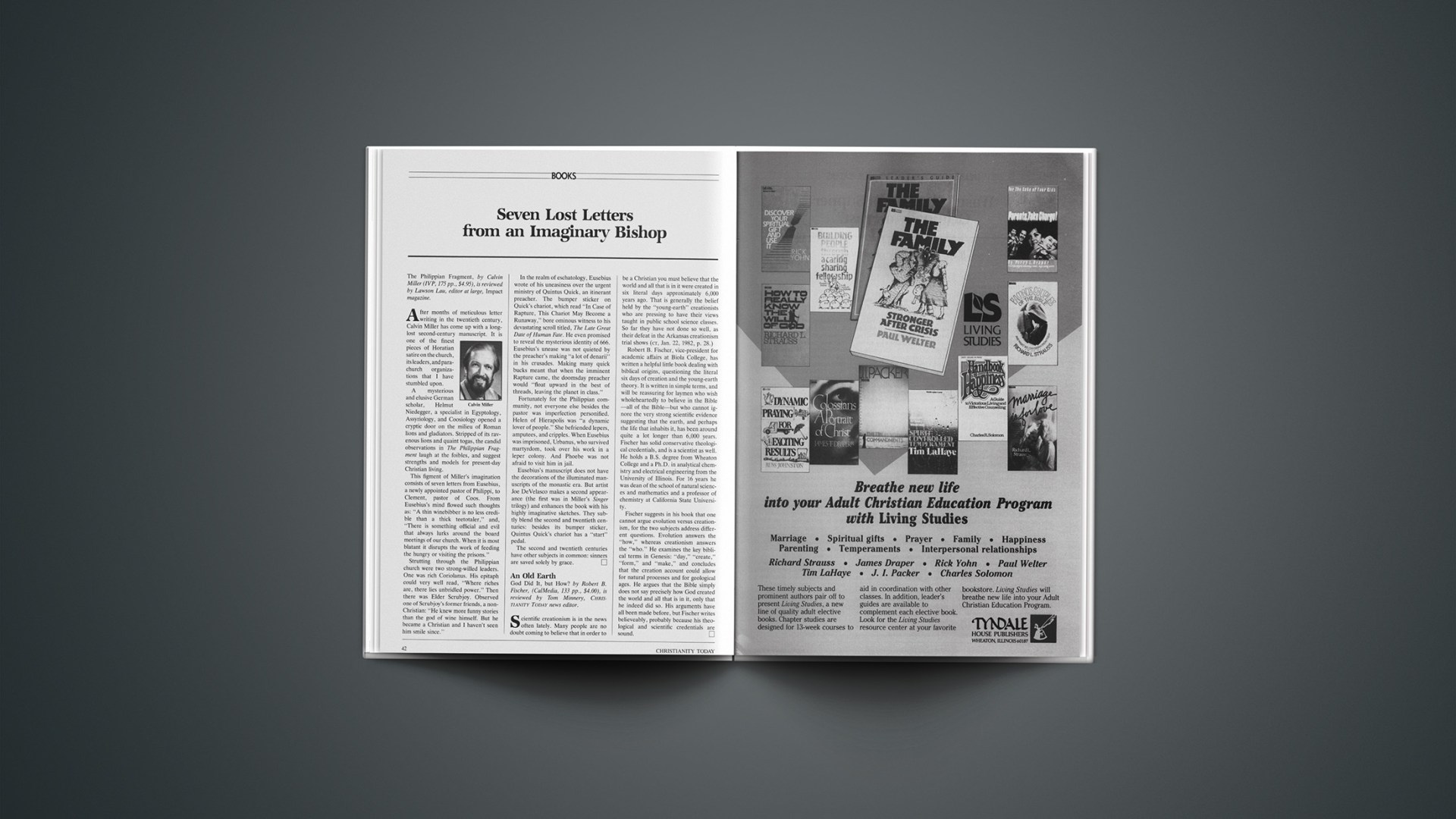The Philippian Fragment, by Calvin Miller (IVP, 175 pp., $4.95), is reviewed by Lawson Lau, editor at large, Impact magazine.
After months of meticulous letter writing in the twentieth century, Calvin Miller has come up with a long-lost second-century manuscript. It is one of the finest pieces of Horatian satire on the church, its leaders, and parachurch organizations that I have stumbled upon.
A mysterious and elusive German scholar, Helmut Niedegger, a specialist in Egyptology, Assyriology, and Coosiology opened a cryptic door on the milieu of Roman lions and gladiators. Stripped of its ravenous lions and quaint togas, the candid observations in The Philippian Fragment laugh at the foibles, and suggest strengths and models for present-day Christian living.
This figment of Miller’s imagination consists of seven letters from Eusebius, a newly appointed pastor of Philippi, to Clement, pastor of Coos. From Eusebius’s mind flowed such thoughts as: “A thin winebibber is no less credible than a thick teetotaler,” and, “There is something official and evil that always lurks around the board meetings of our church. When it is most blatant it disrupts the work of feeding the hungry or visiting the prisons.”
Strutting through the Philippian church were two strong-willed leaders. One was rich Coriolanus. His epitaph could very well read, “Where riches are, there lies unbridled power.” Then there was Elder Scrubjoy. Observed one of Scrubjoy’s former friends, a non-Christian: “He knew more funny stories than the god of wine himself. But he became a Christian and I haven’t seen him smile since.”
In the realm of eschatology, Eusebius wrote of his uneasiness over the urgent ministry of Quintus Quick, an itinerant preacher. The bumper sticker on Quick’s chariot, which read “In Case of Rapture, This Chariot May Become a Runaway,” bore ominous witness to his devastating scroll titled, The Late Great Date of Human Fate. He even promised to reveal the mysterious identity of 666. Eusebius’s unease was not quieted by the preacher’s making “a lot of denarii” in his crusades. Making many quick bucks meant that when the imminent Rapture came, the doomsday preacher would “float upward in the best of threads, leaving the planet in class.”
Fortunately for the Philippian community, not everyone else besides the pastor was imperfection personified. Helen of Hierapolis was “a dynamic lover of people.” She befriended lepers, amputees, and cripples. When Eusebius was imprisoned, Urbanus, who survived martyrdom, took over his work in a leper colony. And Phoebe was not afraid to visit him in jail.
Eusebius’s manuscript does not have the decorations of the illuminated manuscripts of the monastic era. But artist Joe DeVelasco makes a second appearance (the first was in Miller’s Singer trilogy) and enhances the book with his highly imaginative sketches. They subtly blend the second and twentieth centuries: besides its bumper sticker, Quintus Quick’s chariot has a “start” pedal.
The second and twentieth centuries have other subjects in common: sinners are saved solely by grace.
An Old Earth
God Did It, but How? by Robert B. Fischer, (CalMedia, 133 pp., $4.00), is reviewed by Tom Minnery, CHRISTIANITY TODAY news editor.
Scientific creationism is in the news often lately. Many people are no doubt coming to believe that in order to be a Christian you must believe that the world and all that is in it were created in six literal days approximately 6,000 years ago. That is generally the belief held by the “young-earth” creationists who are pressing to have their views taught in public school science classes. So far they have not done so well, as their defeat in the Arkansas creationism trial shows (CT, Jan. 22, 1982, p. 28.)
Robert B. Fischer, vice-president for academic affairs at Biola College, has written a helpful little book dealing with biblical origins, questioning the literal six days of creation and the young-earth theory. It is written in simple terms, and will be reassuring for laymen who wish wholeheartedly to believe in the Bible—all of the Bible—but who cannot ignore the very strong scientific evidence suggesting that the earth, and perhaps the life that inhabits it, has been around quite a lot longer than 6,000 years. Fischer has solid conservative theological credentials, and is a scientist as well. He holds a B.S. degree from Wheaton College and a Ph.D. in analytical chemistry and electrical engineering from the University of Illinois. For 16 years he was dean of the school of natural sciences and mathematics and a professor of chemistry at California State University-
Fischer suggests in his book that one cannot argue evolution versus creationism, for the two subjects address different questions. Evolution answers the “how,” whereas creationism answers the “who.” He examines the key biblical terms in Genesis: “day,” “create,” “form,” and “make,” and concludes that the creation account could allow for natural processes and for geological ages. He argues that the Bible simply does not say precisely how God created the world and all that is in it, only that he indeed did so. His arguments have all been made before, but Fischer writes believeably, probably because his theological and scientific credentials are sound.










